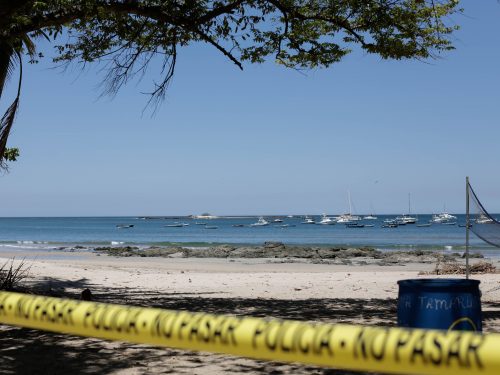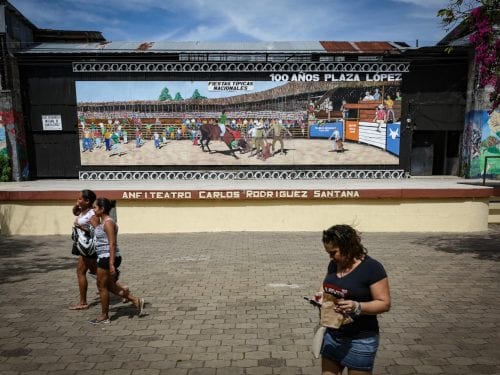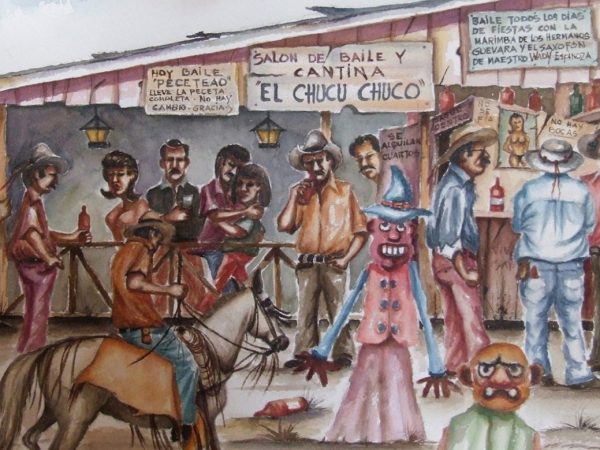
The Barrio Lajas school is a few blocks from the heart of Santa Cruz. It is wrapped in cables and surrounded by dirt roads with water that ruins them. Once inside, Elias and Tyra, two students in fifth grade, take charge of showing me another world of circuits, robots and videogames created by them.
Elias asks professor Ivan Rosales is she can show me the video game that he is working on now. He is so excited that he gets desperate while the computer he shares with Tyra boots up. He wants in front of the m onitor for what seems like an eternity.

Professor Margoth Pena transfers the study plan to her pre-school class to the computer lab to give technological challenges to students, according to the topic they are studying. For example, the water cycle.Photo: César Arroyo
The professor, meanwhile, tells me the school is classified as “priority attention.” It’s part of a program by the Public Health Ministry (MEP) that seeks to improve the quality of the lives the students in marginale urban shone have. He is in charge of the lab and “physical computing” where they teach kids in preschool to sixth grade about programming, circuits, cables and motors.
“This type of contact helps them open paths in areas where they never have explored,” says Rosales before continuing with her class.

In Barrio Lajas, they give physical computing at early ages. Students in pre-school learn programming through icons that move robots from one place to the next.Photo: César Arroyo
Technology started to be a tool important in Barrio Lajas five years ago when the information program for Omar Dengo Foundation joined the education information one. But beyond math and technical learning the students must always respond to the same question before staring a project. What for?
The response is a determining factor. “So we build something for the students that have other kinds of capacities or we go out to see problems of pollution that there are in the community,” Ivan says.
In the corners of the room are projects that the professor refers to. Like the ballot box designed so a classmate with motor discapacity could vote in student elections. Or the mock up with vowels and numbers that is activated through touch and applause, programmed by students in fifth grade for a girl with cerebral paralysis.

The concepts they learn in the first class, like cartesian plans and coordinates, are used later to create their own video games.Photo: César Arroyo
They have equipped the school with alarms against fires and bombings with heat sensors that turn off on their own when the students leave them on.
But the projects aren’t limited to school pavilions. When they go out to investigate what problems there are in the community they run into a lot of trash. “So we sign up to solve it creating a smart trash can to motivate the population to use it more,” Rosales says. Besides the trash can with sensors, that opens when someone goes near it to throw out trash, they survey residents to learn how many people recycle in the neighborhood and that way learn to do a database in the lab.
Roxana Molina took over as director of the school seven years ago. We went to her small office to talk to her and she responds quickly, jumping ahead of our questions. “Each time we participate in a science fair we focus on the robotic part and we have classified nationally.”

Elias Espinoza, fifth grade student, shows every single part of the robot he’s using during physics computer classes.
Three years ago they won honorable mention in the Science and Technology Fair of 2016 with their robot Curiosity, which helps blind people identify obstacles through sensors.
The lack of broadband and teaching staff trained in technology are two of the biggest obstacles in laboratories in the province. But the results seen at Barrio Lajas aren’t coincidence, they have assigned money in their budget to buy their own equipment and also for their scientific fairs.
Not all children will chose a tech career, but they feel motivated with just having the option. “I like it a lot because I learn things that I might need in the future,” says Tyra, who wants to be an obstetrician when she grows up.

The Barrio Lajas is a school with priority attention and many of the kids that it receives have economic difficulties and social problems in their homes.
Or her classmate Elias that, while he wants to study law like his dad, understands that when he programs and builds something new he must do it with purpose. “This is for the children to get motivated to build robots when they grow up and make one to help society.”







Comments